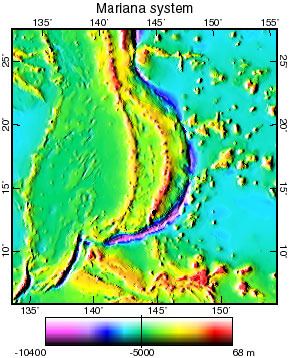8. Bird, P. (1978c) Stress and temperature in subduction shear zones: Tonga and Mariana, Geophys. J. R. Astron. Soc., 55, 411-434.
Abstract. Because there is secondary sea-floor spreading in the Tonga and Mariana subduction systems, the island arcs are separate plates. Horizontal forces on the two sides of the arc must balance, and the maximum force on the back-arc side can be calculated from a lithostatic ridge model. This, in combination with gravity data, allows calculation of the average shear stress in the top 100 km of the subduction shear zone. Stress in Tonga is 220 ± 100 bar, and in the Mariana it is 165 ± 75 bar. These low stresses are probably made possible by a fluid pore pressure almost equal to the least compressive stress.
Knowledge of stress allows approximate calculation of temperature in the shear zone by integration of a single differential equation. These temperatures are too low to activate most dehydration reactions in the subducted crust. As it approaches the volcanic line, this crust is at 150-350° C in Tonga and 150-300° C in the Mariana. Shear melting of the crust is ruled out, and conductive melting of the slab by contact with the asthenosphere meets with geochemical objections. Magmas in these systems are probably produced by partial melting of asthenosphere, triggered by a sudden release of water from the slab.
P.S. (1) Bars are not SI. Convert 220 ± 100 bar = 22 ± 10 MPa; 165 ± 75 bar = 16.5 ± 7.5 MPa. (2) Although this is a minor detail, the treatment of montmorillonite dehydration in this paper was simplistic and wrong. See Bird (1984) for a complete treatment. P. Bird, 2000.08.31




